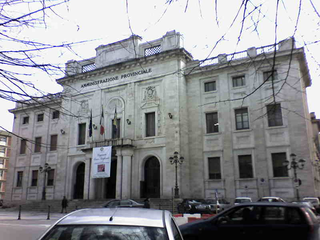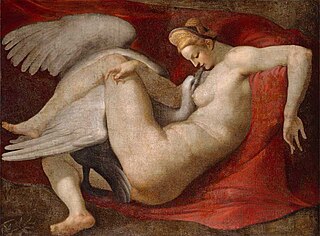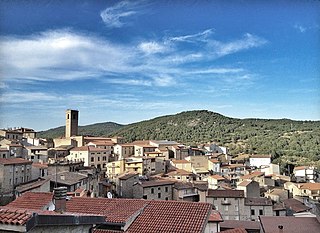
Gavoi is a comune in central Sardinia (Italy), part of the province of Nuoro, in the natural region of Barbagia. It overlooks the Lake of Gusana.

Pavia is a town and comune of south-western Lombardy, northern Italy, 35 kilometres south of Milan on the lower Ticino river near its confluence with the Po. It has a population of c. 73,000. The city was the capital of the Kingdom of the Lombards from 572 to 774.

Noto is a city and comune in the Province of Syracuse, Sicily, Italy. It is 32 kilometres (20 mi) southwest of the city of Syracuse at the foot of the Iblean Mountains. It lends its name to the surrounding area Val di Noto. In 2002 Noto and its church were declared a UNESCO World Heritage Site.

Bevagna is a town and comune in the central part of the Italian province of Perugia (Umbria), in the flood plain of the Topino river.

Itri is a small city and comune the province of Latina, Lazio, central Italy.

Treia is a town and comune in the province of Macerata in the central Marche (Italy). It is 7 kilometres (4.3 mi) north of Pollenza, 12 kilometres (7.5 mi) west of Macerata, and 18 kilometres (11 mi) north-northeast of Tolentino.

Formello is a town and comune in the Metropolitan City of Rome. It is located southwest of the Monti Sabatini, within the Regional Park of Veii. The communal territory is mostly composed by tuff, and is intensively cultivated.
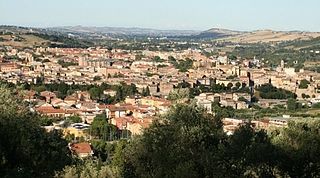
Tolentino is a town and comune of about 20,000 inhabitants, in the province of Macerata in the Marche region of central Italy.

Atessa is an municipality in the province of Chieti, Abruzzo, south-eastern Italy. It is part of the Val di Sangro mountain community. It is the largest municipality in the province by extension and eighth by population.

San Michele in Isola is a Roman Catholic church, located on the Isola di San Michele, a small islet sited between Venice and Murano, which once sheltered a Camaldolese monastery, but now houses the main cemetery of the city. The monastery was mostly demolished in the 19th-century, but the church remains, originally rebuilt starting in 1469. The church is dedicated to Saint Michael, the holder of the scales on Judgement Day, a fit guardian of the sleep of the faithful dead. The island cemetery now includes the land of the formerly separate island of San Cristoforo. This church is sometimes referred to as San Michele di Murano, although this islet is separate from islands comprising that town.

Patti is a town and comune in northeastern Sicily, southern Italy, administratively part of the Metropolitan City of Messina, on the western shore of the gulf of the same name. It is located 76 kilometres (47 mi) from Messina.

Montegaldella is a city in the province of Vicenza, Veneto, northern Italy. The highway SP16 runs through the town.

San Pietro Infine is a comune (municipality) in the Province of Caserta in the Italian region Campania, located about 70 kilometres (43 mi) northwest of Naples and about 50 kilometres (31 mi) northwest of Caserta. San Pietro Infine borders the following municipalities: Mignano Monte Lungo, San Vittore del Lazio, Venafro.
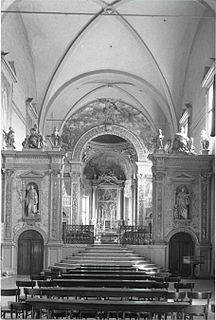
San Michele in Bosco is a religious complex in Bologna, central Italy, including the church with the same name and the annexed Olivetan monastery. The buildings of the monastery were acquired in 1955 by the municipality of Bologna, to house an orthopedic center named the Rizzoli Orthopedic Institute.

Longobards in Italy: Places of Power is seven groups of historic buildings that reflect the achievements of the Germanic tribe of the Lombards, who settled in Italy during the sixth century and established a Lombard Kingdom which ended in 774 A.D.
The Sanctuary of the Madonna del Piano is a Roman Catholic church in the town of Ausonia, province of Frosinone, region of Lazio, Italy.
Santa Maria di Correano is a Romanesque style, Roman Catholic church in the town of Ausonia, province of Frosinone, region of Lazio, Italy.
San Michele is a renaissance-style, Roman Catholic rural parish church located on Piazza San Michele in the neighborhood of Comeana of town of Carmignano, province of Prato, region of Tuscany, Italy.
San Gianuario is a Roman Catholic church located on Largo San Gianuario, in front of the church of San Michele Arcangelo, in the town of Marsico Nuovo, province of Potenza, region of Basilicata, Italy. It is cited as the co-cathedral of the town along with the church of San Giorgio.


